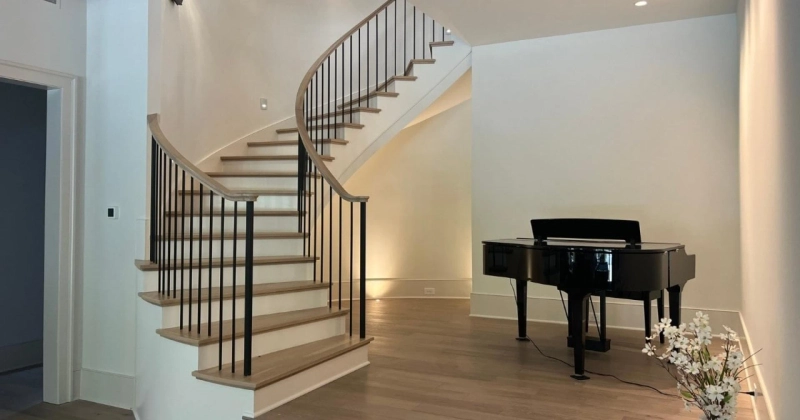A spiral staircase is a unique architectural feature that combines functionality with aesthetic charm. Characterized by a central pole or column with steps winding around it in a helical pattern, this type of staircase can be found in homes, commercial spaces, towers, and even outdoor gardens. The spiral staircase has stood the test of time, dating back to ancient structures, and continues to be a popular choice in modern designs.
In this article, we’ll explore the various uses, advantages, and disadvantages of a spiral staircase to help you decide whether it’s the right choice for your space.
What is a Spiral Staircase?
A spiral staircase is designed around a central support pole, with steps radiating outward and upward in a circular or helical pattern. Unlike straight or L-shaped stairs, the spiral design saves space and creates a visually appealing focal point. While it may take up less floor space, it offers a stylish way to connect different levels of a building.
Common Uses of a Spiral Staircase
A spiral staircase is versatile and fits into many architectural contexts. Below are some common uses:
1. Space-Saving Residential Solutions
In small apartments, lofts, and tiny homes, a spiral staircase provides vertical access without requiring the space of a traditional staircase.
2. Garden and Outdoor Access
These staircases are often used to connect balconies to gardens or rooftops, especially when space is limited.
3. Industrial and Commercial Applications
Warehouses, lighthouses, and observation towers often use spiral staircases due to their compact footprint.
4. Decorative Architectural Feature
Many modern homes incorporate a spiral staircase as a centerpiece, blending function with style.
Advantages of a Spiral Staircase
Choosing a spiral staircase comes with numerous benefits that make it attractive for both residential and commercial spaces.
1. Space Efficiency
A spiral staircase requires less floor area compared to traditional stairs, making it ideal for small rooms or confined spaces.
Key Point:
- Perfect for maximizing usable floor space.
2. Aesthetic Appeal
A spiral staircase adds elegance and visual interest. It can be crafted from various materials like wood, metal, or glass, matching different interior styles.
Key Point:
- Functions as both a staircase and a design statement.
3. Versatility in Design
From rustic wooden spirals to sleek, modern metal versions, the spiral staircase can be customized to suit almost any architectural theme.
Key Point:
- Adaptable to both indoor and outdoor use.
4. Easy Installation in Existing Structures
Installing a spiral staircase can be less invasive compared to traditional staircases, especially in renovation projects.
Disadvantages of a Spiral Staircase
While the spiral staircase offers many advantages, it also comes with a few drawbacks that you should consider.
1. Limited Accessibility
Due to its narrow steps and circular design, a spiral staircase can be challenging for elderly individuals, young children, or people with mobility issues.
Key Point:
- Not always suitable for high-traffic areas.
2. Difficulty in Moving Large Objects
Transporting furniture or large items between floors can be cumbersome on a spiral staircase because of the tight turns.
3. Steeper Treads
Steps on a spiral staircase are often narrower on the inner edge and can be steeper than those of traditional stairs, increasing the risk of slipping.
4. Building Code Restrictions
In some regions, building codes limit where and how a spiral staircase can be used, especially as the primary staircase.
Materials Used in Spiral Staircase Construction
The choice of material greatly influences the appearance, durability, and maintenance of a spiral staircase.
- Wood: Offers a warm, classic look, suitable for traditional interiors.
- Metal: Provides strength and modern appeal, perfect for industrial designs.
- Glass: Creates a sleek and contemporary feel, though requires careful maintenance.
- Concrete: Durable and sturdy, often used for outdoor or public installations.
Safety Considerations for a Spiral Staircase
When installing or using a spiral staircase, safety should be a top priority.
- Proper Handrails: Ensure sturdy, continuous handrails are in place.
- Non-Slip Treads: Choose textured or non-slip materials for better grip.
- Adequate Lighting: Poor lighting increases the risk of accidents, so keep the area well-lit.
- Correct Step Size: Ensure steps are wide enough at the outer edge for safe footing.
Design Ideas for Spiral Staircases
If you want your spiral staircase to be more than just a functional structure, here are a few design inspirations:
- Minimalist Metal Design: Sleek black or white powder-coated metal for modern homes.
- Rustic Wood Finish: Perfect for cabins or traditional interiors.
- Floating Glass Spiral: Ideal for luxury spaces, creating an open and airy atmosphere.
- Outdoor Steel Spiral: Galvanized steel for durability in gardens, patios, or rooftops.
When to Choose a Spiral Staircase
A spiral staircase is an excellent choice if:
- You have limited floor space.
- You want a striking architectural feature.
- The staircase will serve as secondary rather than primary access.
- You’re looking for a customizable design element that can fit your interior style.
However, if accessibility, frequent heavy use, or moving large furniture is a concern, a traditional staircase might be more practical.
Conclusion
A spiral staircase is a timeless and functional architectural feature that blends beauty with practicality. Its space-saving nature, aesthetic appeal, and versatility make it a popular choice for many settings—from compact apartments to luxurious villas. However, it’s essential to weigh its disadvantages, such as limited accessibility and difficulty in moving large objects, before deciding.
By carefully considering its uses, advantages, and potential drawbacks, you can determine whether a spiral staircase is the perfect fit for your home or project. With the right materials, design, and safety measures, this elegant staircase style can transform any space into a visually captivating and efficient environment.



